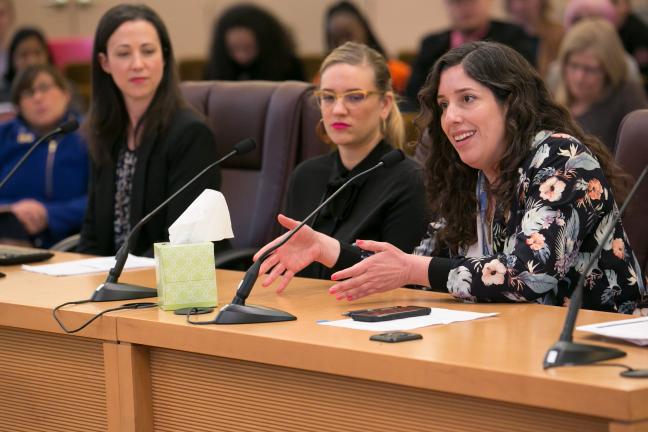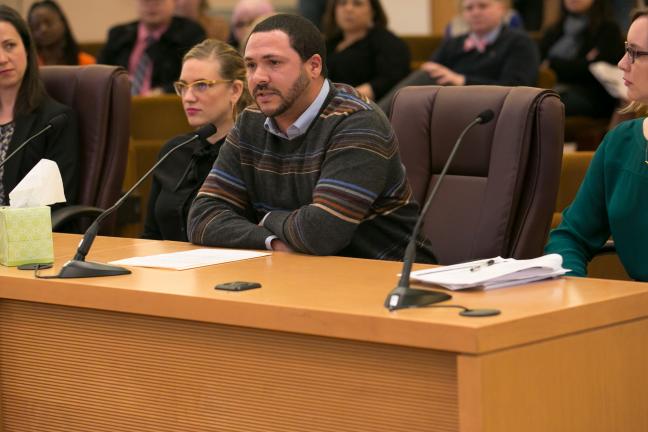The Multnomah County Board of Commissioners heard detailed results -- some shared publicly for the first time -- from two countywide studies on workforce trends and employee survey responses during a board briefing Tuesday morning.
The briefing was designed to offer additional context on employees’ experiences and opportunities ahead of Thursday’s regularly scheduled board meeting. That’s when commissioners are scheduled to hear testimony from employees and vote on the county’s
“There is some troubling information that you’ll hear,” said Marissa Madrigal, the county’s chief operating officer, when presenting the results to the board Tuesday.
“We are presenting this data as a compliment to that testimony in hopes of giving you the fullest possible picture of employee experiences,” she added. “This is the first time that central HR has shared this information publicly. Part of improving things at Multnomah County will require a culture where we can look at difficult data, where we can look at problems, be transparent about them and find solutions together.”
Presenters from the Department of County Management shared their quantitative and qualitative analysis of workforce data from 2013 through 2016, examining trends in hiring, retention, promotion, separations, and overall County demographics as well as results from a workforce survey conducted last fall. The presentation also included preliminary findings on equity and accommodations for people with disabilities.
“This information is considered a baseline,” Anna Plumb, manager of the county’s Evaluation and Research Unit, said of the workforce trends data. But “it can’t tell us the ‘why’ behind the data, which is why we’re presenting it with other data as well.”
WORKFORCE TRENDS DATA
Presenters shared how an employee’s position, identity and status in management/leadership affect outcomes in areas such as hiring and recruitment, advancement, development, retention, and separation.
Jillian Girard, senior research and evaluation analyst, shared workforce data from fiscal year 2013 through 2016:
- The regular workforce is around three-quarters employees who identify as white and about a quarter who identify as employees of color.
- The proportion of employees of color has slowly increased.
- Millennials’ share of the workforce has increased.
- Almost 20 percent of millennials at the county identify as Hispanic or Latino.
“This is consistent with national trends showing an increase in people of color in the millennial generation,” Girard said. “The long-term impact of this will depend on both hiring and retention efforts.”
The county workforce grew by 700 regular employees since fiscal year 2013. Employees hired during fiscal years 2015 and 2016 were:
- 47 percent millennials
- 65 percent female
- And slightly more racially and ethnically diverse than the county’s workforce overall
The county hires employees of color in proportions that are similar to or higher than the estimated local labor pool availability, Girard noted. Employees of color were more likely to receive promotions and more likely to be promoted into union-represented positions. Middle managers, however, are less racially and ethnically diverse than other levels of the organization.
The study also looked at why employees left the county between 2015 to 2016:
- 2.59 percent of employees overall found other employment
- 2.62 percent retired
- 2.59 percent left voluntarily
- And 1.33 percent left involuntarily
Among regular hires, Black or African American employees were more likely to experience a probationary termination. Ten percent of Black or African Americans employees were terminated during their probationary period compared to 4 percent of white employees.
EMPLOYEE SURVEY DATA
The results from last fall’s workforce survey show that the county still has much to do to create an environment where all employees feel valued, supported and that they have equal opportunities to thrive.
More than 3,200 employees – nearly 60 percent of county workers – completed the survey. More than 800 answered an open-ended question about their experience as a county employee.
The survey by the county’s Central Human Resources Office assesses employee views on their work climate, job satisfaction, supervision and training. Staff in the Department of County Management and Office of Diversity and Equity analyze the data, including demographics, to search for the “why” behind the results.
Survey highlights include:
- A 14 percent decline in employees’ overall satisfaction with the way things are going at the county since 2015.
- Employees hold multiple and contradictory views about topics such as diversity. Many staff, from both dominant and non-dominant cultures, said there is not enough focus on equity and diversity in hiring. Many other staff said there is too much focus on diversity and equity.
- Many staff have concerns about nepotism and favoritism in hiring. They believe managers often already have someone in mind that they push the hiring committee to hire.
- Managers make a big difference, in good and bad ways. Some employees feel supported and encouraged by their managers in promotional and professional development opportunities and express more job satisfaction. Other employees do not feel supported at all by their managers to pursue development and advancement opportunities.
- Non-white employees and those who identify as immigrants, refugees or Hispanic, are more likely to feel negatively viewed by co-workers. And they are more likely to leave their job. “When employees do not feel safety, trust and belonging, they are more likely to leave,” said Alison Sachet, senior research and evaluation analyst with the Department of County Management.
- Discrimination is one of many negative reasons employees leave the county, Sachet said. Others include unsupportive managers, an unmanageable workload, negative work environments, frustration with advancement opportunities, and feeling undervalued.
- Employees with disabilities, visible or invisible, are more likely to feel negatively viewed by co-workers than other employees. Said one employee with a disability: “Bottom line: I’m invisible and I’m scared.”
- Employees who identify as “gender expansive” are more likely to feel that they are negatively viewed at work because of their identity.
Plumb noted a troubling overall theme in the survey results. “Identity and organizational position impact employee experiences – who you are and where you sit are really important,” she said. “The data shows it. If it is perceived that it is a disadvantage to be from one group, it could make it harder to recruit and retain people from that group.”
On a positive note, Plumb said that the survey also showed that the county has many strengths it can build on to address negative issues in the workplace.
“County employees are focused on serving the public,” Plumb said. “Ninety-nine percent of employees say they are focused on serving the public with integrity.
“They feel they can make a difference here,” she added, “they are proud to work here, they are fully engaged in their jobs. What’s more – 89 percent of people think that the people in their work unit value diversity. The County workforce cares about their work, and they care about the community. These are foundations to build on.”
Chair Deborah Kafoury said the fact that so many employees love their jobs underlines the importance of addressing problems with job satisfaction.
“Our employees deserve it,” Kafoury said. “Everyone deserves to feel safe here. It is uncomfortable to talk about, but it’s not an accident that we are here. We are dealing with systemic problems that are all too common in our country. We are going to be intentional to get out of this. Just know that we are in this together.”


